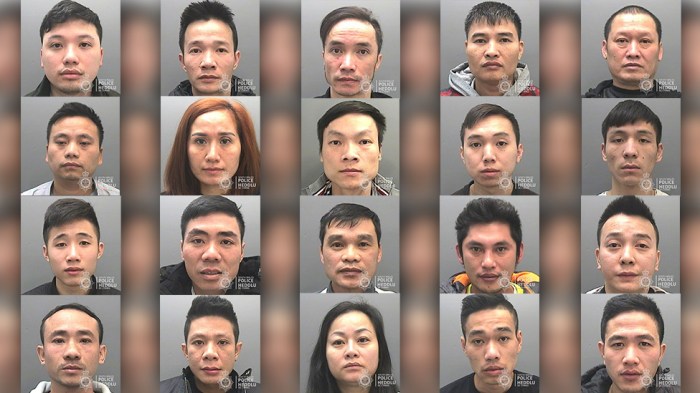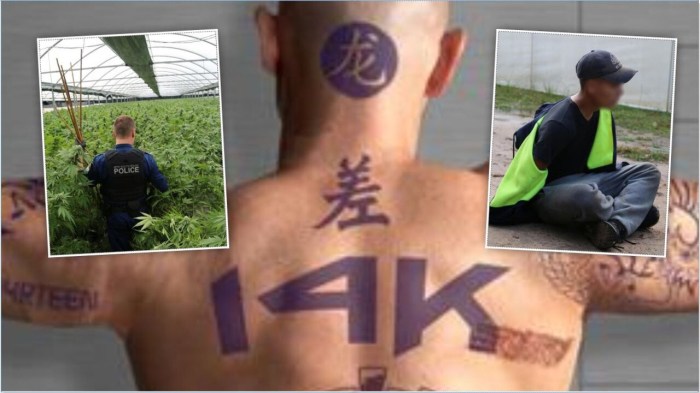Vietnamese gangster in san jose – Vietnamese gangsterism in San Jose has emerged as a significant social issue, shaping the city’s landscape in multifaceted ways. This article delves into the history, types, culture, law enforcement response, community impact, and prevention strategies associated with Vietnamese gangs, providing a comprehensive understanding of their presence and influence.
Types of Vietnamese Gangs in San Jose
Vietnamese gangs in San Jose exhibit diverse characteristics and organizational structures. These gangs range from loosely affiliated groups to highly structured criminal enterprises.
Independent Gangs
Independent Vietnamese gangs are typically small, decentralized groups that operate in specific neighborhoods or territories. They engage in a range of criminal activities, including drug trafficking, robbery, and extortion. Membership in these gangs is often based on familial or friendship ties, and they may have limited connections to other criminal organizations.
Example:The “Little Saigon Boys” are an independent gang known to operate in the Little Saigon neighborhood of San Jose.
National Crime Syndicates
National crime syndicates, such as the “Vietnamese Organized Crime Network” (VOCN), have a more sophisticated organizational structure and operate on a larger scale. They are involved in a wide range of criminal activities, including drug trafficking, money laundering, and human trafficking.
These gangs have a hierarchical structure, with leaders, lieutenants, and foot soldiers. They often have ties to other criminal organizations and operate in multiple cities and states.
Example:The VOCN is a national crime syndicate with a presence in San Jose. It is known for its involvement in drug trafficking and money laundering.
Prison Gangs
Prison gangs, such as the “Vietnamese American Gangster Association” (VGA), are formed within the prison system. These gangs are highly structured and have a strong code of conduct. They engage in a range of criminal activities, including drug trafficking, extortion, and violence.
Prison gangs often have ties to street gangs and may continue to operate outside the prison system.
Example:The VGA is a prison gang with a presence in San Jose. It is known for its involvement in drug trafficking and violence.
Vietnamese Gang Culture: Vietnamese Gangster In San Jose

Vietnamese gangs in San Jose possess a distinct cultural identity that sets them apart from other criminal organizations. This culture is shaped by a combination of traditional Vietnamese values, language, and symbolism.
Traditionplays a significant role in Vietnamese gang culture. Many gangs adopt traditional Vietnamese symbols, such as the dragon, the phoenix, and the lotus flower. These symbols represent strength, beauty, and purity, respectively, and serve as a reminder of the gangs’ Vietnamese heritage.
Languageis another important aspect of Vietnamese gang culture. Many gangs use Vietnamese slang and code words to communicate with each other. This helps them to maintain secrecy and avoid detection by law enforcement.
Symbolismis also used extensively in Vietnamese gang culture. Gang members often wear specific colors or clothing to identify themselves with a particular gang. They may also use hand gestures or tattoos to convey messages to other gang members.
Rituals and Codes of Conduct
Vietnamese gangs have a number of rituals and codes of conduct that govern their behavior. These rituals include initiation ceremonies, which new members must undergo before they are accepted into the gang. Gangs also have strict codes of conduct that govern how members interact with each other and with outsiders.
Values
The values of Vietnamese gangs are based on a combination of traditional Vietnamese values and the values of the criminal underworld. These values include loyalty, honor, and respect. Gang members are expected to be loyal to their gang and to their fellow gang members.
They are also expected to be honorable and to respect the traditions of the gang.
Law Enforcement Response to Vietnamese Gangs

Law enforcement agencies in San Jose have implemented various strategies and tactics to combat Vietnamese gang activity. These include targeted enforcement operations, community outreach programs, and collaboration with federal and state agencies.
Targeted enforcement operations focus on identifying and apprehending gang members involved in criminal activities. These operations often involve the use of undercover officers, surveillance, and wiretaps. Law enforcement agencies have also implemented community outreach programs to build relationships with Vietnamese communities and gain their support in combating gang violence.
These programs include youth mentoring programs, after-school programs, and community policing initiatives.
Collaboration with Federal and State Agencies
Law enforcement agencies in San Jose also collaborate with federal and state agencies to combat Vietnamese gang activity. The FBI and the California Department of Justice provide resources and support to local law enforcement agencies. This collaboration includes sharing intelligence, providing training, and conducting joint operations.
Community Impact of Vietnamese Gangs
The presence of Vietnamese gangs in San Jose has had a profound impact on the community, with far-reaching social, economic, and health consequences.
Social Consequences, Vietnamese gangster in san jose
Gang activity has contributed to increased violence and crime in San Jose. Gang members engage in a range of criminal activities, including drug trafficking, extortion, and human trafficking. This has created a climate of fear and insecurity among residents, particularly in areas with high gang activity.
Economic Consequences
Vietnamese gangs also have a negative impact on the local economy. They often engage in illegal activities that generate revenue, such as drug sales and prostitution. This money is often laundered through legitimate businesses, which can distort the local economy and make it more difficult for legitimate businesses to thrive.
Health Consequences
Gang activity also has a detrimental impact on the health of the community. Gang members are more likely to engage in risky behaviors, such as drug use and unprotected sex. This can lead to a range of health problems, including addiction, HIV/AIDS, and other sexually transmitted diseases.
Perspectives from the Community
Community members affected by Vietnamese gangs express a range of perspectives. Some residents feel unsafe and fear for their lives. Others are concerned about the negative impact of gang activity on the local economy and the health of the community.
However, some community members also recognize that Vietnamese gangs provide a sense of community and protection for their members.
Prevention and Intervention Programs

Prevention and intervention programs play a crucial role in reducing Vietnamese gang activity in San Jose. These programs aim to address the root causes of gang involvement, such as poverty, lack of opportunity, and social isolation.
Goals and Methods
Prevention programs focus on providing youth with positive alternatives to gangs, such as after-school programs, mentoring, and job training. Intervention programs, on the other hand, target individuals who are already involved in gangs or at risk of joining. These programs provide support services, such as counseling, education, and job placement assistance, to help individuals leave gangs and lead productive lives.
Effectiveness
Numerous studies have shown that prevention and intervention programs can be effective in reducing gang activity. For example, a study by the RAND Corporation found that a comprehensive gang prevention program in Los Angeles reduced gang membership by 20%. Another study by the University of California, Irvine, found that an intervention program for gang-involved youth reduced recidivism by 30%.
Successful Approaches
One successful approach to gang prevention is the “Community-Based Participatory Research” (CBPR) model. This model involves community members in all aspects of the program, from planning to implementation and evaluation. CBPR programs have been shown to be more effective than traditional top-down approaches, as they are tailored to the specific needs of the community.Another
promising approach to gang intervention is the “Cognitive Behavioral Therapy” (CBT) model. CBT focuses on changing the thoughts and behaviors that contribute to gang involvement. CBT programs have been shown to be effective in reducing gang-related violence and recidivism.
FAQ
What factors have contributed to the rise of Vietnamese gangs in San Jose?
Factors such as poverty, immigration, and cultural isolation have played a role in the formation and growth of Vietnamese gangs in the city.
What are the key characteristics of Vietnamese gang culture?
Vietnamese gangs often maintain strong ties to their cultural heritage, incorporating traditions, language, and symbols into their identity and activities.
How does law enforcement respond to Vietnamese gang activity in San Jose?
Law enforcement agencies employ various strategies, including targeted patrols, undercover operations, and community outreach programs, to combat Vietnamese gang activity.